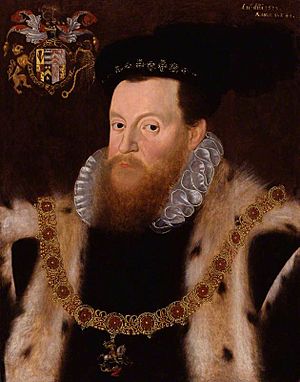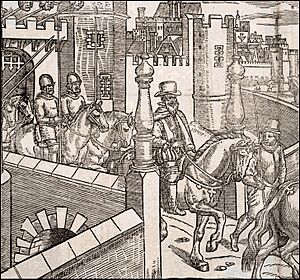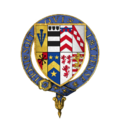Henry Sidney facts for kids
Quick facts for kids
Henry Sidney
|
|
|---|---|

Portrait by Arnold Bronckorst, 1573
|
|
| Born | 20 July 1529 |
| Died | 5 May 1586 |
| Offices | Lord Deputy of Ireland Lord President of Wales |
| Noble family | Sidney |
| Issue | Sir Philip Sidney Mary Margaret Sidney Elizabeth Sidney Mary, Countess of Pembroke Robert Sidney, 1st Earl of Leicester Ambrosia Sidney Sir Thomas Sidney |
| Father | Sir William Sidney |
| Mother | Anne Pakenham |
Sir Henry Sidney KG (born July 20, 1529 – died May 5, 1586) was an important English politician. He was the oldest son of Sir William Sidney, who was also a well-known politician. Henry Sidney grew up at the royal court. He was a friend to Prince Edward, who later became King Edward VI.
Henry Sidney continued to be favored by the English monarchs. He served under Queen Mary I and especially under Queen Elizabeth I. He played a big part in England's efforts to control Ireland. He served three times as the Lord Deputy of Ireland, which was like being the Queen's main representative there. His career had its challenges both in England and in Ireland.
Contents
Sir Henry Sidney's Family Life
Henry Sidney was born to Anne Pakenham and Sir William Sidney. In 1551, he married Mary Dudley. She was the oldest daughter of John Dudley, 1st Duke of Northumberland. Henry and Mary had seven children together.
Their oldest son was Sir Philip Sidney, who became a famous poet and soldier. Their second son was Robert Sidney, 1st Earl of Leicester. Their daughter, Mary Sidney, married Henry Herbert, 2nd Earl of Pembroke. She was known for her writing and was one of the most celebrated women of her time.
Sidney's Important Career Roles
First Journey to Ireland
In 1556, Sidney went to Ireland. He worked with the Lord Deputy, Thomas Radclyffe, 3rd Earl of Sussex. The Lord Deputy had married Sidney's sister, Frances, the year before. Both men served Queen Mary until she died in 1558.
Sidney helped expand English rule in Ireland. At that time, English control was mostly limited to an area around Dublin called the Pale. He also helped bring Irish leaders under English rule. This was part of a plan called "Surrender and Regrant." In 1557, Sidney's actions led to the devastation of Rathlin Island.
When the Lord Deputy was away in England, Sidney was in charge of Ireland. He showed great skill in governing. When Queen Elizabeth became queen, Sidney was again in charge. He handled problems with Shane O'Neill very skillfully. Around this time, Sidney became the president of the council in Wales. He then lived mostly at Ludlow Castle.
A Visit to Scotland
Queen Elizabeth sent Sidney to Scotland in July 1562. His job was to delay a meeting between Elizabeth and Mary, Queen of Scots. The Scottish queen was upset by this news and cried.
An unusual event happened when Sidney was with Mary Queen of Scots. A man named Captain Hepburn approached the queen and gave her a paper. This happened while she was talking to Sidney in the garden of Holyrood Palace. Hepburn then ran away to England. Mary was particularly offended that this happened during her meeting with Sidney.
Serving as Lord Deputy

In 1565, Sidney was appointed Lord Deputy of Ireland again. He replaced Sir Nicholas Arnold. Sidney felt that the English Pale was in a worse state than when he left it. He believed Shane O'Neill, a powerful Irish leader, was causing the most trouble.
Sidney convinced Queen Elizabeth to allow strong actions against O'Neill. O'Neill avoided a big battle. But Sidney helped O'Neill's rival, Calvagh O'Donnell, regain his rights. He also placed an English army base at Derry. This was to stop O'Neill from gaining more power.
In 1567, Shane O'Neill was defeated by another Irish group, Clan O'Donnell. Shane then surrendered to Clan MacDonnell of Antrim. They killed him during a feast as part of a secret deal with Sidney. After this, Sidney focused on the south of Ireland. He caused a disagreement between two powerful Irish leaders, Gerald FitzGerald, 14th Earl of Desmond, and Thomas Butler, 10th Earl of Ormond. He also punished or imprisoned others he saw as troublemakers.
Sidney then returned to Ulster. He made Turlough Luineach O'Neill, Shane's replacement, submit to English rule. Sidney placed English soldiers at Belfast and Carrickfergus. This helped control both Clan O'Donnell and Clan MacDonnell of Antrim.
Challenges in Ireland
In the autumn of 1567, Sidney went back to England for ten months. When he returned, he asked Lord Burghley to help develop Ireland. Sidney wanted to build roads and bridges. He also wanted to replace the Irish clan system with English land ownership. He aimed to reduce traditional Irish customs across the island.
In 1569, he opened a parliament in Dublin. This was the first one in ten years. He suggested creating the Court of Castle Chamber. This was an Irish version of the English Star Chamber court. The Queen supported this idea, and it was set up after Sidney was called back to England.
Sidney also suggested appointing military governors in the regions of Munster and Connacht. This led to the first of the Desmond Rebellions. These rebellions were led by James Fitzmaurice Fitzgerald. English forces put them down very harshly by 1573. Sidney then turned his attention to the Butler family in Ormond and Kilkenny. They had rebelled against land claims made by Sir Peter Carew. In 1570, many of Sir Edmund Butler's followers were hanged. Three brothers of Thomas Butler, 3rd Earl of Ormonde, lost their rights by an act of the Irish parliament.
Sidney left Ireland in 1571. He was unhappy that Queen Elizabeth did not show enough appreciation for his work. In September 1575, he returned with more royal authority. He found things were even worse than before. In Antrim, MacQuillan of the Route and Sorley Boy MacDonnell were causing clan conflicts. Sidney calmed this northern area. Then he went south and was successful in making his authority respected there too.
Sidney made lasting changes to the way Ireland was divided. He created shire divisions, similar to English counties. Earlier, he had combined the Ardes and Clandeboye areas to form the county of Carrickfergus. He also turned the country of Clan O'Farrell into County Longford. He did similar things in Connacht. There, the lands of Clan O'Brien in Thomond became County Clare. The counties of Galway, Mayo, Sligo, and Roscommon were also created.
Sidney also put down a rebellion led by the earl of Clanricarde and his sons in 1576. He pursued Rory O'More until his death two years later.
Later Years and Legacy
From his position on the Privy Council in London, Sidney used his influence during the Second Desmond Rebellion. This conflict led to many deaths in Munster between 1579 and 1583. It also resulted in the plantation of the province. This meant that English and Scottish settlers moved to Ireland.
Sidney spent the rest of his life mostly at Ludlow Castle. He continued his duties as president of the Welsh Marches.
Images for kids
See also
- Rathlin Island Massacre


